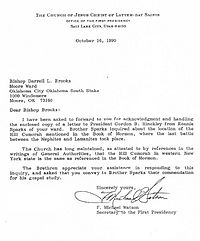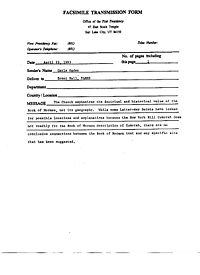- REDIRECT Template:Headers and footers:Main Page
Did the First Presidency identify the New York "Hill Cumorah" as the site of the Nephite final battles?
Questions
Did the First Presidency identify the New York "Hill Cumorah" as the site of the Nephite final battles?
To see citations to the critical sources for these claims, click here
Answer
The First Presidency's secretary apparently answered a question according to his own understanding, and then at the direction of the First Presidency later clarified/corrected his statement to indicate that while many Latter-day Saints have expressed opinions about the location of Cumorah (or other Book of Mormon geography issues), the Church has no official geography. No revelatory basis exists for any geographical scheme outside of the Book of Mormon text itself.
Detailed Analysis
Initial letter
In 1990, F. Michael Watson (secretary to the First Presidency) sent a letter to a questioner which read as follows:
- The Church of Jesus Christ of Latter-Day Saints
- Office of the First Presidency
- Salt Lake City, Utah 84150
- October 16, 1990
- Bishop Darrel L. Brooks
- Moore Ward
- Oklahoma City Oklahoma South Stake
- 1000 Windemere
- Moore, OK 73160
- Dear Bishop Brooks:
- I have been asked to forward to you for acknowledgment and handling the enclosed copy of a letter to President Gordon B. Hinckley from Ronnie Sparks of your ward. Brother Sparks inquired about the location of the Hill Cumorah mentioned in the Book of Mormon, where the last battle between the Nephites and Lamanites took place.
- The Church has long maintained, as attested to by references in the writings of General Authorities, that the Hill Cumorah in western New York state is the same as referenced in the Book of Mormon.
- The Brethren appreciate your assistance in responding to this inquiry, and asked that you convey to Brother Sparks their commendation for his gospel study.
- Sincerely yours,
- (signed)
- F. Michael Watson
- Secretary to the First Presidency
|
 Letter from F. Michael Watson sent 16 October 1990. |
Clarification
It is apparent that Bro. Watson seems to have been speaking on his own understanding of the matter, and not as an official declaration of Church policy. Two statements made available within the next three years clarified the Church's opinion on the matter. The first was the publication of the Encyclopedia of Mormonism. Although not an official statement of Church policy, two members of the Quorum of the Twelve, Elders Oaks and Maxwell, served as advisers during the production of the Encyclopedia. Thus, we have the following statement published in 1992:
In 1928 the Church purchased the western New York hill and in 1935 erected a monument recognizing the visit of the angel Moroni (see Angel Moroni Statue). A visitors center was later built at the base of the hill. Each summer since 1937, the Church has staged the Cumorah Pageant at this site. Entitled America's Witness for Christ, it depicts important events from Book of Mormon history. This annual pageant has reinforced the common assumption that Moroni buried the plates of Mormon in the same hill where his father had buried the other plates, thus equating this New York hill with the Book of Mormon Cumorah. Because the New York site does not readily fit the Book of Mormon description of Book of Mormon geography, some Latter-day Saints have looked for other possible explanations and locations, including Mesoamerica. Although some have identified possible sites that may seem to fit better (Palmer), there are no conclusive connections between the Book of Mormon text and any specific site that has been suggested.
—David A. Palmer, "Cumorah" in Daniel H. Ludlow, ed., Encyclopedia of Mormonism.
|
On April 23, 1993, F. Michael Watson arranged for a clarification letter after a discussion with a FARMS staffer. The text is similar and consistent with what was published in the Encyclopedia of Mormonism the previous year:
The Church emphasizes the doctrinal and historical value of the Book of Mormon, not its geography. While some Latter-day Saints have looked for possible locations and explanations [for Book of Mormon geography] because the New York Hill Cumorah does not readily fit the Book of Mormon description of Cumorah, there are no conclusive connections between the Book of Mormon text and any specific site.[1]
Since the text of this letter was published in the Journal of Book of Mormon Studies, some critics have charged the FARMS authors with either manipulating the Church into sending the letter, or forging the letter text altogether.
Matt Roper of the Neal A. Maxwell Institute for Religious Scholarship located a faxed copy of the same statement sent from the Office of the First Presidency, along with its cover page, and sent FAIR a copy with permission to post it. The 1993 fax was sent by Senior Executive Secretary for the Office of the First Presidency, Carla Ogden, to Brent Hall of FARMS. (Sister Ogden continues to serve in this position as of 2009). The text of the fax matches exactly the text reported to have been in the response by Watson as described in the FARMS Review. The cover letter reads as follows:
I thought you would be interested in this FAX from Michael Watson, secretary to the First Presidency. We have been receiving a number of questions from the Oklahoma, Texas area where anti-Mormons are using a letter from Brother Watson to a Bishop where Brother Watson said that the Church supports only one location for Cumorah, and that is the New York location. I talked with him on the phone the other day and told him of the questions that were coming to us. He responded that the First Presidency would like to clear up that Issue and he would FAX me with that clarification.
Thanks
[signed]
Brent [Hall]
|
 Fax from the Office of the First Presidency to FARMS dated April 23, 1993. |
(Phone and numbers have been redacted from these scans; they are otherwise unaltered. The top of the First Presidency's fax had "Apr 23 '93 12:25 PM FIRST PRESIDENCY SLC P.1" in fainter letters applied by the receiving fax, which does not appear on the scan.)
Joseph Fielding Smith
Critics sometimes appeal to remarks by Joseph Fielding Smith that argue for a New York location. One review of this topic noted:
- In 1938 Elder Joseph Fielding Smith wrote an article published in the Deseret News arguing against what he then termed the "modernist" theory that the final battlefield of the Nephites and Jaredites may have been in Central America rather than in New York. In 1956 this article was included in a selection of Elder Smith's writings compiled by his son-in-law Bruce R. McConkie. Although Elder Smith would later become president of the church in 1970, his article arguing for a New York location as the scene of the final battlefield was written many years before he assumed that position, and he apparently never revisited the question as president of the church. There is evidence that Elder Smith may have softened his opposition on the Cumorah question. In a letter written to Fletcher B. Hammond, who argued emphatically for a Central American location and had sent Elder Smith a copy of his findings, the apostle explained, "I am sure this will be very interesting although I have never paid any attention whatever to Book of Mormon geography because it appears to me that it is inevitable that there must be a great deal of guesswork." Apparently, he did not consider his 1938 argument as settled and definitive or as a measure of doctrinal orthodoxy.
- Sidney B. Sperry, after whom an annual Brigham Young University symposium is named, was also one who initially supported the New York Cumorah view (that is, an area of New York as the final battlefield of the Nephites and Jaredites). During the 1960s, as he began to explore the issue, he came to a different conclusion... Reversing his earlier position, he wrote: "It is now my very carefully studied and considered opinion that the Hill Cumorah to which Mormon and his people gathered was somewhere in Middle America. The Book of Mormon evidence to this effect is irresistible and conclusive to one who will approach it with an open mind. This evidence has been reviewed by a few generations of bright students in graduate classes who have been given the challenge to break it down if they can. To date none has ever been able to do so." Sperry, who was very familiar with what Joseph Fielding Smith had previously written, told him that he did not feel comfortable publishing something that contradicted what the apostle had written, but that he and other sincere students of the Book of Mormon had come to that conclusion only after serious and careful study of the text. Sperry said that Elder Smith then lovingly put his arm around his shoulder and said, "Sidney, you are as entitled to your opinion as I am to mine. You go ahead and publish it." [2]
It seems clear, then, that Elder (later President) Smith did not regard his views as the product of revelation, nor did he regard it as illegitimate to have a different view of the matter.
Notes
- ↑ Correspondence from Michael Watson, Office of the First Presidency, 23 April 1993. Cited with commentary in William J. Hamblin, "Basic Methodological Problems with the Anti-Mormon Approach to the Geography and Archaeology of the Book of Mormon," Journal of Book of Mormon Studies 2/1 (1993). [161–197] link
- ↑ Matthew Roper, "Losing the Remnant: The New Exclusivist "Movement" and the Book of Mormon (A review of "Prophecies and Promises: The Book of Mormon and the United States of America" by: Bruce H. Porter and Rod L. Meldrum)," FARMS Review 22/2 (2010): 87–124. off-site wiki

